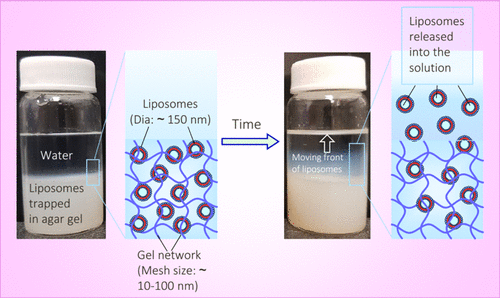Our official English website, www.x-mol.net, welcomes your
feedback! (Note: you will need to create a separate account there.)
Liposomes Entrapped in Biopolymer Hydrogels Can Spontaneously Release into the External Solution.
Langmuir ( IF 3.7 ) Pub Date : 2020-06-16 , DOI: 10.1021/acs.langmuir.0c00596 Benjamin R Thompson 1 , Brady C Zarket 2 , E Hunter Lauten 2 , Samiul Amin 2 , Sivaramakrishnan Muthukrishnan 2 , Srinivasa R Raghavan 1
Langmuir ( IF 3.7 ) Pub Date : 2020-06-16 , DOI: 10.1021/acs.langmuir.0c00596 Benjamin R Thompson 1 , Brady C Zarket 2 , E Hunter Lauten 2 , Samiul Amin 2 , Sivaramakrishnan Muthukrishnan 2 , Srinivasa R Raghavan 1
Affiliation

|
Hydrogels of biopolymers such as agar and gelatin are widely used in many applications, and in many cases, the gels are loaded with nanoparticles. The polymer chains in these gels are cross-linked by physical bonds into three-dimensional networks, with the mesh size of these networks typically being 10–100 nm. One class of “soft” nanoparticles are liposomes, which have an aqueous core surrounded by a lipid bilayer. Solutes encapsulated in the liposomal core can be delivered externally over time. In this paper, we create liposomes with diameters ∼150 nm from an unsaturated phospholipid (lecithin) and embed them in agar gels (the aqueous phase also contains 0–50% of glycerol, which is an active ingredient in cosmetic products). Upon placing this gel in quiescent water, we find that the liposomes release out of the gel into the water over a period of 1–3 days, even though the gel remains intact. This is a surprising result that runs contrary to our expectation that the liposomes would simply remain immobilized in the gel. We show that the release rate of liposomes can be tuned by several variables: for example, the release rate increases as the agar concentration is lowered and the rate increases steadily with temperature. In addition to agar, release of liposomes also occurs out of other physical gels including those of agarose and gelatin. However, liposomes made from a saturated phospholipid do not release out of any gels. We discuss a possible mechanism for liposomal release, which involves intact liposomes deforming and squeezing through transient large pores that arise in physical networks such as agar. Our findings have relevance to transdermal delivery: they suggest the possibility of systematically delivering liposomes loaded with actives out of an intact matrix.
中文翻译:

生物聚合物水凝胶中截留的脂质体可以自发释放到外部溶液中。
诸如琼脂和明胶之类的生物聚合物的水凝胶被广泛用于许多应用中,并且在许多情况下,凝胶中都装有纳米颗粒。这些凝胶中的聚合物链通过物理键交联成三维网络,这些网络的筛孔大小通常为10–100 nm。一类“软”纳米颗粒是脂质体,其具有被脂质双层包围的水核心。包封在脂质体核心中的溶质可随时间推移向外传递。在本文中,我们从不饱和磷脂(卵磷脂)中制备直径约150 nm的脂质体,并将其嵌入琼脂凝胶中(水相还含有0–50%的甘油,这是化妆品中的活性成分)。将此凝胶放入静态水中后,这是令人惊讶的结果,与我们的预期相反,脂质体将仅保持固定在凝胶中。我们显示脂质体的释放速率可以通过几个变量进行调整:例如,随着琼脂浓度降低,释放速率增加,并且随着温度的升高,释放速率稳定增加。除了琼脂,脂质体的释放也发生在其他物理凝胶之外,包括琼脂糖和明胶。但是,由饱和磷脂制成的脂质体不会从任何凝胶中释放出来。我们讨论脂质体释放的一种可能的机制,其中涉及完整的脂质体变形和挤压通过在琼脂等物理网络中出现的瞬态大孔。我们的发现与透皮给药有关:他们暗示了将含有活性成分的脂质体从完整基质中系统递送的可能性。
更新日期:2020-07-07
中文翻译:

生物聚合物水凝胶中截留的脂质体可以自发释放到外部溶液中。
诸如琼脂和明胶之类的生物聚合物的水凝胶被广泛用于许多应用中,并且在许多情况下,凝胶中都装有纳米颗粒。这些凝胶中的聚合物链通过物理键交联成三维网络,这些网络的筛孔大小通常为10–100 nm。一类“软”纳米颗粒是脂质体,其具有被脂质双层包围的水核心。包封在脂质体核心中的溶质可随时间推移向外传递。在本文中,我们从不饱和磷脂(卵磷脂)中制备直径约150 nm的脂质体,并将其嵌入琼脂凝胶中(水相还含有0–50%的甘油,这是化妆品中的活性成分)。将此凝胶放入静态水中后,这是令人惊讶的结果,与我们的预期相反,脂质体将仅保持固定在凝胶中。我们显示脂质体的释放速率可以通过几个变量进行调整:例如,随着琼脂浓度降低,释放速率增加,并且随着温度的升高,释放速率稳定增加。除了琼脂,脂质体的释放也发生在其他物理凝胶之外,包括琼脂糖和明胶。但是,由饱和磷脂制成的脂质体不会从任何凝胶中释放出来。我们讨论脂质体释放的一种可能的机制,其中涉及完整的脂质体变形和挤压通过在琼脂等物理网络中出现的瞬态大孔。我们的发现与透皮给药有关:他们暗示了将含有活性成分的脂质体从完整基质中系统递送的可能性。











































 京公网安备 11010802027423号
京公网安备 11010802027423号